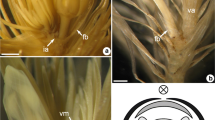Abstract
InMazus pumilus, all the floral appendages are initiated in acropetal sequence in the second cell layer (except stamens) of the floral primordium by periclinal divisions. The actinomorphic calyx tube is formed due to zonal growth. The zygomorphy in corolla is evident from the inception of petal primordia which arise sequentially as independent units in order of one anterior, a pair of anterio-lateral followed by a pair of posterio-lateral. Later these primordia exhibit differential growth because of which zygomorphy becomes more pronounced. The upper corolla tube is formed by interprimordial growth and lower corolla tube by zonal growth. Stamens are initiated in the third layer of the floral apex. Unlike sepals and petals, in the development of stamens (4) underlying cells of corpus also contribute. Posterior stamen is absent. The stamens become epipetalous because of interprimordial and zonal growth in the common region below the bases of petals as well as stamens. The two carpel primordia arise as crescent shaped structures which become continuous due to interprimordial growth. The ovary is formed by a ring of zonal meristem. The style develops later between stigma and ovary because of intercalary growth. The residual apex grows vertically along with the ovary and forms the septum of the ovary. All the floral appendages exhibit similar pattern of histogenesis and early growth suggesting thereby the appendicular nature of these appendages.
Similar content being viewed by others
References
Awasthi, D.K., V. Kumar andY.S. Murty. 1984. Flower development inAntirrhinum majus L. (Scrophulariaceae) with a comment upon corolla tube formation. Bot. Mag. Tokyo97: 13–22.
Boke, N.H. 1948. Development of the perianth inVinca rosea L. Amer. J. Bot.35: 413–423.
— 1949. Development of the stamens and carpels inVinca rosea L. Amer. J. Bot.36: 535–547.
Cusick, F. 1966. On phylogenetic and ontogenetic fusions.In E.G. Cutter, ed., Trends in Plant Morphogenesis, pp. 170–183. Longmans, London.
Daniel, E. andR. Sattler. 1978. Development of perianth tubes ofSolanum dulcamara: Implications for comparative morphology. Phytomorphology28: 151–171.
Eames, A.J. 1961. Morphology of the Angiosperms. McGraw-Hill, New York.
Engard, C.J. 1944. Organogenesis inRubus. Univ. Hawaii Res. Publ. 21.
Esau, K. 1965. Plant Anatomy, 2 ed. John Willey and Sons, New York.
Gifford, E.M., Jr. 1951. Early ontogeny of the foliage leaf inDrimys winteri var.Chilensis. Amer. J. Bot.38: 93–105.
Hagemann, W. 1970. Studien Zur Entwicklungsgeschichte der Angiospermen Blatter. Bot. Jahrb.90: 297–413.
Hara, N. 1957. On the types of the marginal growth in Dicotyledonous foliage leaves. Bot. Mag. Tokyo.70: 108–114.
— 1959. Marginal growth in leaves. Nature.183: 1409–1410.
Hartl, D. 1956. Morphologische studien am Pistil des Scrophulariaceen. Osterr. Bot. Ztschr.103: 185–242.
Kaplan, D.R. 1967. Floral morphology, organogenesis and interpretation of the inferior ovary inDowningia bacigalupii. Amer. J. Bot.54: 1274–1290.
— 1968a. Structure and development to the perianth inDowningia bacigalupii. Amer. J. Bot.55: 406–420.
— 1968b. Histogenesis of the androecium and gynoecium inDowningia bacigalupii. Amer. J. Bot.55: 933–950.
Kasalpligil, B. 1951. Morophological and ontogenetic studies ofUmbellularia californica Nutt. andLaurus nobilis L. Univ. Calif. Publ. Bot.25: 115–239.
Kaussmann, B. 1941. Vergleichende Untersuchungen Über die Blattnature der Kelch, Blumen, und Staubblätter. Bot. Arch.42: 503–572.
Leins, P. andV. Gemmeke, 1979. Infloreszenz- und Blütenentwicklung bei der KugeldistelEchinops exaltatus (Asteraceae). Pl. Syst. Evol.132: 189–204.
McCoy, R.W. 1940. Floral organogenesis inFrasera caroliniensis. Amer. J. Bot.27: 600–609.
Miller, H.A. andR.H. Wetmore. 1946. Studies in the developmental anatomy ofPhlox drummondii Hook. III. The apices of mature plant. Amer. J. Bot.33: 1–10.
Nishino, E. 1976. Developmental anatomy of foliage leaves, bracts, calyx and corolla inPharbitis nil. Bot. Mag. Tokyo89: 191–209.
— 1978. Corolla tube formation in four species of Solanaceae. Bot. Mag. Tokyo91: 263–277.
— 1982. Corolla tube formation in six species of Apocynaceae. Bot. Mag. Tokyo95: 1–17.
— 1983a. Corolla tube formation in the Tubiflorace and Gentianales. Bot. Mag. Tokyo96: 223–243.
— 1983b. Corolla tube formation in the Primulaceae and Ericales. Bot. Mag. Tokyo96: 319–342.
Puri, V. 1952. Placentation in angiosperms. Bot. Rev.18: 603–651.
Robyns, A. 1955. Morphologie en morphogenese van het bloemapparat bijCentaurium minus car. en.,C. vulgare Rafn. Varhandl. kon. Vlaamse. Acad. Wetensch. Let. Schone Kunst. Van Palgië Klasse Westensch.51: 1–85.
Sattler, R. 1977. Kronrohrenentstechung beiSolanum dulcamara L. und “Kongenitale Verwachsung”. Ber. Deutsch. Bot. Ges.90: 29–38.
Singh, V. 1979. Early floral development inDigitalis purpurea L. Phytomorphology29: 239–245.
— andD.K. Jain. 1979. Floral organogenesis ofAntirrhinum majus L. (Scrophulariaceae). Proc. Indian Acad. Sci.88: 183–188.
Sprotte, K. 1940. Untersuchungen über Wachstum und Nervatur der Fruchtblätter. Bot. Arch.40: 463–506.
Takhtajan, A.D. 1959. Die Evolution der Angiospermen. Gustav Fischer, Jena.
— 1969. Flowering Plants: Origin and Dispersal. Oliver and Boyd, Edinburgh.
Tepfer, S.S. 1953. Floral anatomy and ontogeny inAquilegia formosa var.truncata andRanunculus repens. Univ. Calif. Publ. Bot.25: 513–648.
Tucker, S.C. 1959. Ontogeny of the influrescence and the flower inDrimys winteri var.chilensis. Univ. Calif. Publ. Bot.30: 257–336.
— andE.M. Gifford Jr. 1966. Organogenesis in the carpellate flower ofDrimys lanceolata. Amer. J. Bot.53: 433–442.
Varghese, T.M. 1969. Morphological studies in the family-Scrophulariaceae. Ph. D. Thesis, Agra University, Agra, India.
Zimmerman, W. 1959. Die Phylogenie der Planzen. Gustav Fischer, Stuttgart.
Author information
Authors and Affiliations
Rights and permissions
About this article
Cite this article
Rawat, R., Awasthi, D.K. & Kumar, V. Floral ontogeny inMazus pumilus (Scrophulariaceae). Bot. Mag. Tokyo 101, 459–471 (1988). https://doi.org/10.1007/BF02488088
Received:
Accepted:
Issue Date:
DOI: https://doi.org/10.1007/BF02488088




